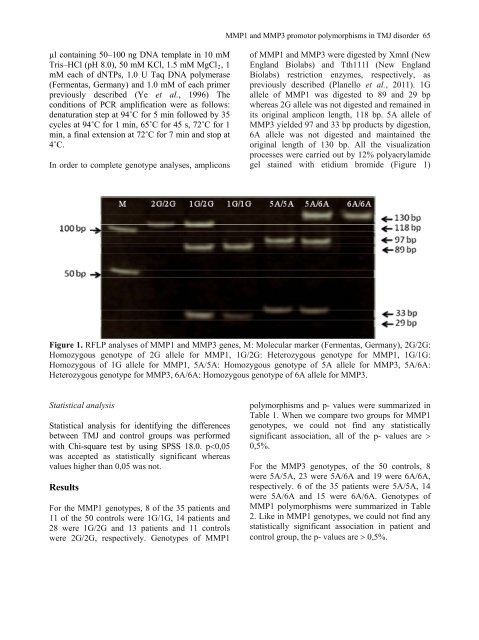Vol 9 No1 - Journal of Cell and Molecular Biology - Haliç Üniversitesi
Vol 9 No1 - Journal of Cell and Molecular Biology - Haliç Üniversitesi
Vol 9 No1 - Journal of Cell and Molecular Biology - Haliç Üniversitesi
You also want an ePaper? Increase the reach of your titles
YUMPU automatically turns print PDFs into web optimized ePapers that Google loves.
µl containing 50–100 ng DNA template in 10 mM<br />
Tris–HCl (pH 8.0), 50 mM KCl, 1.5 mM MgCl2, 1<br />
mM each <strong>of</strong> dNTPs, 1.0 U Taq DNA polymerase<br />
(Fermentas, Germany) <strong>and</strong> 1.0 mM <strong>of</strong> each primer<br />
previously described (Ye et al., 1996) The<br />
conditions <strong>of</strong> PCR amplification were as follows:<br />
denaturation step at 94˚C for 5 min followed by 35<br />
cycles at 94˚C for 1 min, 65˚C for 45 s, 72˚C for 1<br />
min, a final extension at 72˚C for 7 min <strong>and</strong> stop at<br />
4˚C.<br />
In order to complete genotype analyses, amplicons<br />
MMP1 <strong>and</strong> MMP3 promotor polymorphisms in TMJ disorder 65<br />
<strong>of</strong> MMP1 <strong>and</strong> MMP3 were digested by XmnI (New<br />
Engl<strong>and</strong> Biolabs) <strong>and</strong> Tth111I (New Engl<strong>and</strong><br />
Biolabs) restriction enzymes, respectively, as<br />
previously described (Planello et al., 2011). 1G<br />
allele <strong>of</strong> MMP1 was digested to 89 <strong>and</strong> 29 bp<br />
whereas 2G allele was not digested <strong>and</strong> remained in<br />
its original amplicon length, 118 bp. 5A allele <strong>of</strong><br />
MMP3 yielded 97 <strong>and</strong> 33 bp products by digestion,<br />
6A allele was not digested <strong>and</strong> maintained the<br />
original length <strong>of</strong> 130 bp. All the visualization<br />
processes were carried out by 12% polyacrylamide<br />
gel stained with etidium bromide (Figure 1)<br />
Figure 1. RFLP analyses <strong>of</strong> MMP1 <strong>and</strong> MMP3 genes, M: <strong>Molecular</strong> marker (Fermentas, Germany), 2G/2G:<br />
Homozygous genotype <strong>of</strong> 2G allele for MMP1, 1G/2G: Heterozygous genotype for MMP1, 1G/1G:<br />
Homozygous <strong>of</strong> 1G allele for MMP1, 5A/5A: Homozygous genotype <strong>of</strong> 5A allele for MMP3, 5A/6A:<br />
Heterozygous genotype for MMP3, 6A/6A: Homozygous genotype <strong>of</strong> 6A allele for MMP3.<br />
Statistical analysis<br />
Statistical analysis for identifying the differences<br />
between TMJ <strong>and</strong> control groups was performed<br />
with Chi-square test by using SPSS 18.0. p0,05<br />
was accepted as statistically significant whereas<br />
values higher than 0,05 was not.<br />
Results<br />
For the MMP1 genotypes, 8 <strong>of</strong> the 35 patients <strong>and</strong><br />
11 <strong>of</strong> the 50 controls were 1G/1G, 14 patients <strong>and</strong><br />
28 were 1G/2G <strong>and</strong> 13 patients <strong>and</strong> 11 controls<br />
were 2G/2G, respectively. Genotypes <strong>of</strong> MMP1<br />
polymorphisms <strong>and</strong> p- values were summarized in<br />
Table 1. When we compare two groups for MMP1<br />
genotypes, we could not find any statistically<br />
significant association, all <strong>of</strong> the p- values are <br />
0,5%.<br />
For the MMP3 genotypes, <strong>of</strong> the 50 controls, 8<br />
were 5A/5A, 23 were 5A/6A <strong>and</strong> 19 were 6A/6A,<br />
respectively. 6 <strong>of</strong> the 35 patients were 5A/5A, 14<br />
were 5A/6A <strong>and</strong> 15 were 6A/6A. Genotypes <strong>of</strong><br />
MMP1 polymorphisms were summarized in Table<br />
2. Like in MMP1 genotypes, we could not find any<br />
statistically significant association in patient <strong>and</strong><br />
control group, the p- values are 0,5%.

















